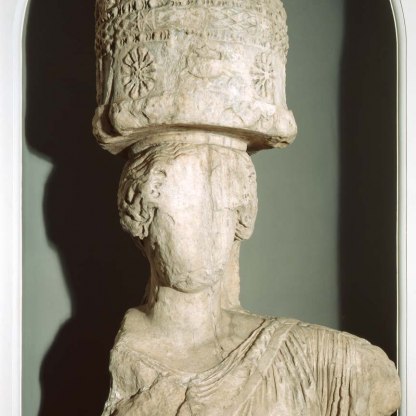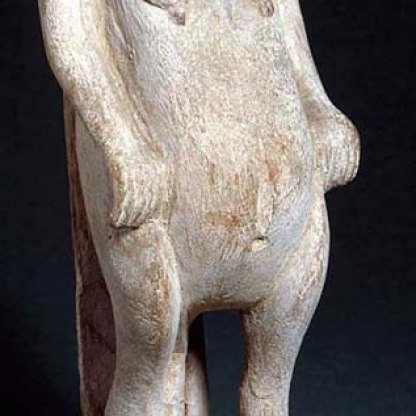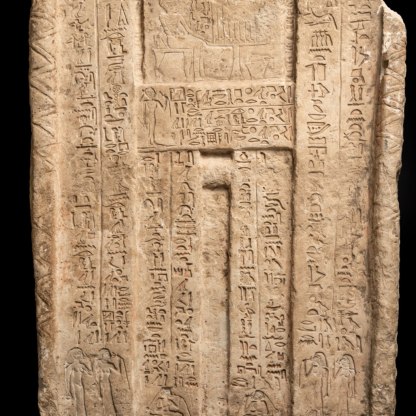Caryatid

In 1801 the Cambridge professor E. D. Clarke visited the village of Eleusis near Athens, once the site of an important sanctuary dedicated to Demeter, the Greek goddess of corn and fertility. He observed this statue
'in the midst of a heap of dung, buried as high as the neck',
and went on to explain that
'the inhabitants of the village still regard [it] with a very high degree of veneration. They attributed to its presence the fertility of the land, and it was for this reason that they heaped around it the manure intended for their fields.'
Like the superstitious villagers, Clarke had made the mistake of thinking that the statue represented Demeter herself. In fact it is probably a priestess of her cult, one of a pair that supported the lintel of a monumental gateway leading to the inner area of the goddess’s sanctuary. A reconstruction of this can be seen, left. Such supporting figures in Greek architecture are called caryatids.
Only the colossal torso, head and headgear survive today, but the statue orginally represented a full-length girl, arms raised above her head to hold the tall, cylindrical object that balances upon it. This is a cista, a sort of container often used in the ancient world to hold cosmetics. The Fitzwilliam owns a third-century BCE bronze example from near Rome, left [GR.3.1965].
That held by the caryatid probably contained sacred objects associated with the rites conducted at Eleusis. Demeter’s cult was a mystery religon, and devotees swore solemnly never to reveal its secrets. It is still not known what may have been carried in the priestess’ cista.
The vessel is decorated with emblems and items used during rituals at the sanctuary: ears of corn, rosettes, cakes, bundles of myrtle. Carved directly above the brow of the caryatid is a plemochoe, a vessel that probably contained the kykeon, the sacred drink used during initiation into the cult.
The caryatid wears two tunics, secured with diagonally crossing straps. A gorgon’s head brooch decorates her chest. The girl’s face, now obliterated, was originally inclined to the left, as though she was looking down onto those passing in procession through the gateway beneath her. The Fitzwilliam caryatid’s sister – who is in a rather better state of preservation – can be seen today in the museum at Eleusis. It has been suggested that the pair were idealised portraits of the daughters of Appius Claudius Pulcher, the Roman consul who dedicated the gateway that they supported, between 54 and 48 BCE.
Recognising the quality and importance of this statue, Clarke decided to remove it. He winched the statue out of its dungy bed and shipped it to England. But it did not travel willingly: the ship carrying the caryatid, and other items collected by Clarke, sank off Beachy Head on the south coast of England (though most of the pieces were later salvaged).
Themes and periods
Data from our collections database
Caryatid
Acquisition and important dates
- Method of acquisition: Given
- Dates: 1865
Dating
carved
- Early Roman
- Production date: circa 50 BC
Maker(s)
Note
Carved
Place(s) associated
- Attica
Materials used in production
Read more about this recordAudio description
Stories, Contexts and Themes
Other highlight objects you might like
Suggested Curating Cambridge products
Sign up to our emails
Be the first to hear about our news, exhibitions, events and more…







